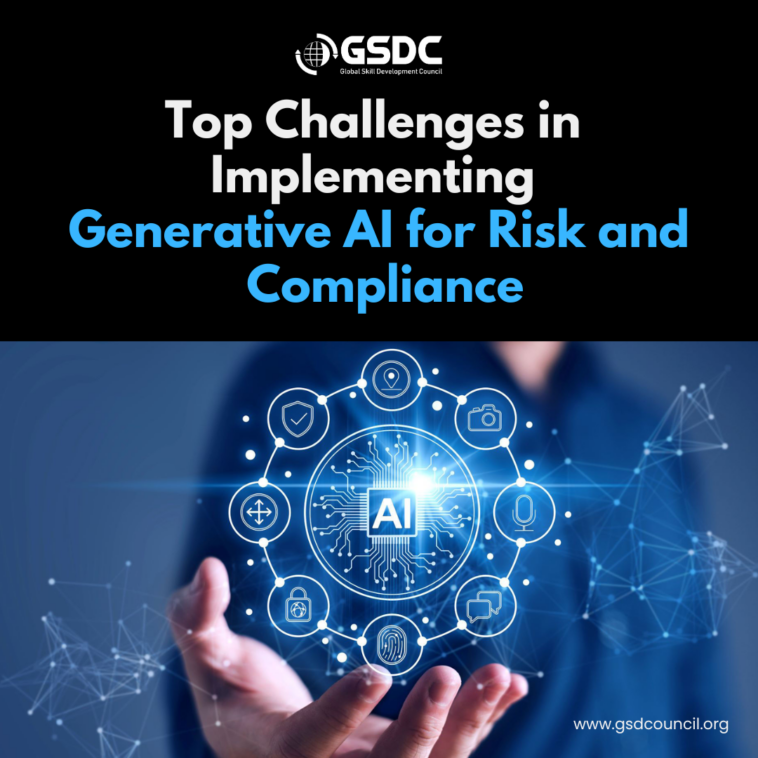The Generative AI in Risk & Compliance Certification is a tailored program to help professionals currently working in the field of risk management and compliance. It provides all the necessary knowledge and competencies to derive the maximum benefits from generative AI technologies.
Barriers to Generative AI in risk and compliance include organizational navigation of key areas necessary for the adoption to be workable and effective. Many of these challenges originate, first and foremost, with the complexity of AI technologies themselves, second from the regulatory landscape, and third from fitting the AI capabilities within organizational goals. In the following, there will be a more in-depth look at the top challenges:
1. Data Quality and Availability
Challenge: Data is lifeblood for AI models. Commonly, organizations are plagued with problems related to data fragmentation, inconsistent data, and incompleteness of data. AI models thrive on substantial volumes of clean and well-structured data.
Impact: Poor quality data will lead to poor AI predictions, misinformed decisions, and possibly an increase in risk exposure. Lacking data can lead to AI models not considering basic factors of risk or even compliance concerns.
Solution: Organizations should develop a strong data governance framework which ensures the provision of clean, accurate, and complete data. It should therefore include data integration from multiple sites, cleaning of data, and regular policies to monitor the quality of data.
2. Model Interpretability and Transparency
Challenge: For many organizations, generative AI models are “black boxes,” by which is meant that they operate in a very complex manner. Undesirable transparency issues in risk and compliance surely can arise from this.
Impact: Inability to interpret an AI model generally hinders the potential building of stakeholder trust in AI outputs, thereby acting as a drag to the adoption of AI-driven decisions. Besides, a number of regulatory bodies challenge such AI systems most, primarily because they want explanations for decisions based on AI, often in matters touching on compliance.
Solution: Techniques that introduce explain ability into AI decision processes are important. Organizations must strive to develop models that balance accuracy with interpretability and clearly document how AI systems derive specific conclusions.
3. Ethical and Bias Considerations
The bigger problem with AI systems is that, often inadvertently, they might perpetuate biases in the data they are trained on, resulting in outcomes that can be unfair and unethical. Of course, this is most catastrophic within compliance, where AI decisions may result in disproportionately adverse impacts on certain groups or amount to discriminatory practices.
Impact: The organization faces legal and reputational risks as a result of bias in AI models. Ethical failures will undermine stakeholder trust and lead to penalties from regulators.
Solution: Organizations should avoid bias by training their AI models using diverse and representative datasets. Fairness-aware algorithms and bias audits may help identify and catch all the potential ethical issues in advance. It is also important to set an ethical code for AI use.
4. Integration with Existing Systems
Challenge: The integration of generative AI into conventional systems of risk management and compliance is—markedly—fraught with many hiccups, from compatibility to interacting with older systems and the need for huge changes in workflows and processes.
Impact: Bad integration can lead to inefficiency, disrupt operations, and make it impossible to realize the full benefits of AI. There is resistance to change within the organization, which further complicates integration efforts.
Solution: Adoption of AI in organizations should be done in a phased manner and should, basically, start from a pilot project that tests compatibility and processes further. This makes it that crucial that AI systems are designed in a way that they are compatible with other infrastructures while investing a deal in change management strategies that help promote the adoption.
5. Skills and Knowledge Gap
Challenge: Development and management of generative AI systems require highly skilled resources, which usually cannot be found within organizations. The level of complexity found in AI technologies leads to very huge skills gaps, hence making it very difficult to have the needed expertise developed or sourced.
The impact: lack of sufficient skills will lead to ideal operationalization and constant management of AI systems, which in turn will lead to poor performance or, in the worst-case scenario, failure.
Solution: Organizations should invest in training and development programs that might involve teaching the latest available AI technologies. Furthermore, collaboration with academic institutions or partnering with other organizations can also help to fill the required skilled gap. Facilities for continuous learning should also be provided to cope with advancements in AI technologies.
6. Cost Entreating and Resource Allocation to AI Technologies
Challenge: Generative AI systems require a lot of resources – both financially and in the investments to build the necessary infrastructure, as well as in creating the required workforce resources. These systems can also be very expensive to maintain and update.
Impact: This will result in high costs and burden organizational budgets and resources, which could foreseeably delay or scale back other AI initiatives. With lack of regular and adequate investments, therefore, the AI projects are likely to fail.
Solution: Justification of investment in AI through adequate cost-benefit analysis before implementation. Scaling up AI solutions to meet growing needs should be done through due diligence, optimizing the use of resources by focusing on areas of highest impact that can benefit most from AI implementation.
Combining generative AI with risk and compliance will create a complex landscape of interrelated technical, regulatory, and organizational challenges. Proper implementation of this requires both strategy and appropriate investment in resources with a long-term commitment to learning and adaptation. On the subject of technical challenges, the use of generative AI in risk and compliance fails to trump the problems related to putting data and technology into practice. Overcoming it means that organizations will unleash the full power of transforming their risk management and compliance efforts to make them more operationally efficient, effective, and forward-looking.
For more information – https://www.gsdcouncil.org/certified-generative-ai-in-risk-and-compliance
This post was created with our nice and easy submission form. Create your post!





